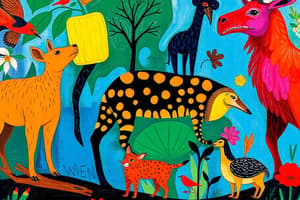Podcast
Questions and Answers
What does morphological diversity refer to?
What does morphological diversity refer to?
- Variety of behaviors among different animal species
- Variety of sounds produced by different animal species
- Variety of habitats among different animal species
- Variety of physical characteristics among different animal species (correct)
Where can high animal diversity be found?
Where can high animal diversity be found?
- Arctic ecosystems
- Desert ecosystems
- Urban ecosystems
- Marine ecosystems (correct)
How can the conservation of animal diversity help ecosystems?
How can the conservation of animal diversity help ecosystems?
- Causing habitat destruction in ecosystems
- Accelerating climate change in ecosystems
- Maintaining the health and stability of ecosystems (correct)
- Increasing pollution in ecosystems
What should future research focus on according to the text?
What should future research focus on according to the text?
Why is understanding and conserving animal diversity essential?
Why is understanding and conserving animal diversity essential?
What role does animal diversity play in ecosystems?
What role does animal diversity play in ecosystems?
Why is animal diversity considered a critical aspect of our planet's ecosystem?
Why is animal diversity considered a critical aspect of our planet's ecosystem?
How does species diversity contribute to ecosystem productivity?
How does species diversity contribute to ecosystem productivity?
What does genetic diversity refer to?
What does genetic diversity refer to?
How can genetic diversity contribute to animal breeding and conservation?
How can genetic diversity contribute to animal breeding and conservation?
Which type of animal diversity is measured by species richness?
Which type of animal diversity is measured by species richness?
How do larger predators contribute to the balance of the food web?
How do larger predators contribute to the balance of the food web?
Flashcards
Animal Diversity
Animal Diversity
The variety of different animal species, including their genetic, morphological, and ecological characteristics.
Importance of Animal Diversity
Importance of Animal Diversity
Enhances ecosystem productivity and stability through complementary species interactions and complex food webs.
Species Diversity
Species Diversity
The number of different species of animals found in a specific area.
Genetic Diversity
Genetic Diversity
Signup and view all the flashcards
Morphological Diversity
Morphological Diversity
Signup and view all the flashcards
Conservation of Animal Diversity
Conservation of Animal Diversity
Signup and view all the flashcards
Role of Animal Diversity
Role of Animal Diversity
Signup and view all the flashcards
High Animal Diversity Ecosystems
High Animal Diversity Ecosystems
Signup and view all the flashcards
Conserving Animal Diversity
Conserving Animal Diversity
Signup and view all the flashcards
Study Notes
Animal Diversity
Animal diversity is a critical aspect of our planet's ecosystem. It refers to the variety of different species of animals found worldwide, including their genetic, morphological, and ecological characteristics. Animal diversity plays a significant role in shaping ecosystems and maintaining the balance of nature.
The Importance of Animal Diversity
Animal diversity is essential for the functioning of ecosystems. It increases the complementarity of species, allowing them to interact in ways that enhance ecosystem productivity and stability. For example, different species of herbivores may feed on different parts of plants, reducing competition for resources and increasing overall plant biomass. Furthermore, larger predators occupy higher trophic positions, forming distinct trophic levels and inducing cascading effects that maintain the balance of the food web.
Types of Animal Diversity
Animal diversity can be categorized into several types, including:
-
Species Diversity: This refers to the variety of different species of animals found in a given area. It can be measured through indices such as species richness (the number of different species) or species evenness (the relative abundance of each species).
-
Genetic Diversity: This refers to the variety of genetic material within a species. It is important for maintaining the health and resilience of populations and can also be a source of genetic resources for animal breeding and conservation.
-
Morphological Diversity: This refers to the variety of physical characteristics among different species of animals. It can include body size, shape, color, and behavior.
Animal Diversity in Different Ecosystems
Animal diversity varies across different ecosystems, from marine and freshwater systems to terrestrial ecosystems. For example, marine ecosystems can have high animal diversity, with a wide range of species interacting in complex food webs. Similarly, terrestrial ecosystems, such as forests and grasslands, can support a high degree of animal diversity, with many different species of plants and animals co-existing.
Conservation of Animal Diversity
The conservation of animal diversity is crucial for maintaining the health and stability of ecosystems. This can be achieved through various measures, including habitat protection, species reintroduction, and the management of human activities that can impact animal populations.
Future Directions
Understanding animal diversity and its role in ecosystems is essential for developing effective conservation strategies and mitigating the impacts of human activities on the natural world. Future research should focus on understanding the factors that influence animal diversity, such as climate change and habitat fragmentation, and developing innovative conservation strategies that can help to protect and restore animal populations.
In conclusion, animal diversity is a vital component of our planet's ecosystems. It plays a crucial role in maintaining the balance of nature and supports a wide range of ecological processes. Understanding and conserving animal diversity is essential for the health and resilience of ecosystems and the well-being of future generations.
Studying That Suits You
Use AI to generate personalized quizzes and flashcards to suit your learning preferences.




